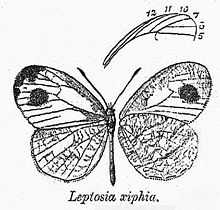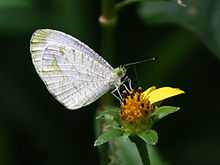Leptosia nina
| Psyche | |
|---|---|
.jpg) | |
 | |
| Scientific classification | |
| Kingdom: | Animalia |
| Phylum: | Arthropoda |
| Class: | Insecta |
| Order: | Lepidoptera |
| Family: | Pieridae |
| Genus: | Leptosia |
| Species: | L. nina |
| Binomial name | |
| Leptosia nina (Fabricius, 1793) | |
| Synonyms | |
| |
The Psyche (Leptosia nina) is a small butterfly of the family Pieridae (the Sulphurs, Yellows and whites) and is found in Southeast Asia and the Indian subcontinent. The upper forewing has a black spot on a mainly white background. The flight is weak and erratic and the body of the butterfly bobs up and down as it beats its wings. They fly low over the grass and the butterfly rarely leaves the ground level.
Description

From Bingham, C.T. (1907). The Fauna of British India, Including Ceylon and Burma. Butterflies. Vol 2.
- Unpublished MS of de Niceville gives it the common name of "wandering snowflake"
- Upperside: white; base of wings very slightly powdered with minute black scales. Forewing: costa speckled obscurely with black; apex black, the inner margin of this inwardly angulate; a very large somewhat pear-shaped post-discal spot also black. Hindwing white, uniform; in most specimens an obscure, extremely slender, terminal black line.

Underside: white, coastal margin and apex of forewing broadly, and the whole surface of the hindwing irrorated with transverse, very slender, greenish strigae and minute dots; these on the hindwing have a tendency to form subbasal, medial and discal obliquely transverse obscure bands; forewing: the postdiscal black spot as on the upperside; terminal margins of both fore and hind wings with minute black, short, transverse slender lines at the apices of the veins, that have a tendency to coalesce and form a terminal continuous line as on the upperside. Antennae dark brown spotted with white, head slightly brownish, thorax and abdomen white. Female: similar, the black markings on the upperside of the forewing on the whole slightly broader, but not invariably so.
- Wingspan: 25–53 mm
- Habitat: The lower ranges of the Himalayas from Mussoorie to Sikkim; Central, Western and Southern India, but not in the desert-tracts; Ceylon; Assam; Burma and Tenasserim; extending to China and the Malayan region.
- Larva: Green with a pale glaucous tinge about the bases of the legs and slightly hairy. Feeds on capers. Capparis zeylanica has been noted as a food plant.[1]
- Pupa: Sometimes green, but more often of a delicate pink shade. Both the larva and pupa are very like those of Terias hecabe, but more delicately formed. (Davidson, Bell and Aitken quoted in Bingham)
Subspecies
Listed alphabetically.[2]
- Leptosia nina aebutia Fruhstorfer, 1910 (Tanahdjampea, Kalao)
- Leptosia nina chlorographa Hübner, [1813] (Java)
- Leptosia nina comma Fruhstorfer, 1903 (Timor to Tanimbar)
- Leptosia nina dione (Wallace, 1867) (southern Sulawesi)
- Leptosia nina fumigata Fruhstorfer, 1903 (Lombok, Sumbawa, Flores, Solor)
- Leptosia nina georgi Fruhstorfer (northern Philippines)
- Leptosia nina malayana Fruhstorfer, 1910 (Peninsular Malaya, Singapore, Sumatra, Borneo, Bangka, Biliton)
- Leptosia nina nicobarica (Doherty, 1886) (Nicobars)
- Leptosia nina nina (India, Ceylon to Indo-China, Thailand, Langkawi, Andamans)
- Leptosia nina niobe (Wallace, 1866) (Taiwan)
- Leptosia nina terentia Fruhstorfer (southern Philippines)
Gallery
-
_at_Jayanti%2C_Duars%2C_West_Bengal_W_IMG_5496.jpg)
at Jayanti in Buxa Tiger Reserve in Jalpaiguri district of West Bengal, India
-
_on_a_Ash_Fleabane_or_Little_ironweed_(Vernonia_cinerea)_in_Kolkata_W_IMG_3668.jpg)
on an Ash Fleabane or Little ironweed Cyanthillium cinereum in Kolkata, West Bengal, India
-
_in_Kolkata_W_IMG_3683.jpg)
Camouflaging with the background in Kolkata, West Bengal, India
-
_in_Hyderabad%2C_AP_W_IMG_0363.jpg)
in Hyderabad, India
Notes
- ↑ Kunte, K. (2006). Additions to known larval host plants of Indian butterflies. J. Bombay Nat. Hist. Soc. 103(1):119-120
- ↑ Leptosia nina, funet.fi
References
- Evans, W.H. (1932). The Identification of Indian Butterflies. (2nd Ed). Bombay Natural History Society, Mumbai, India
- Gaonkar, Harish (1996). Butterflies of the Western Ghats, India (including Sri Lanka) - A Biodiversity Assessment of a threatened mountain system. Journal of the Bombay Natural History Society.
- Gay, Thomas; Kehimkar, Isaac & Punetha, J.C. (1992). Common Butterflies of India. WWF-India and Oxford University Press, Mumbai, India.
- Kunte,Krushnamegh (2005). Butterflies of Peninsular India. Universities Press.
- Wynter-Blyth, M.A. (1957). Butterflies of the Indian Region. Bombay Natural History Society, Mumbai, India.
